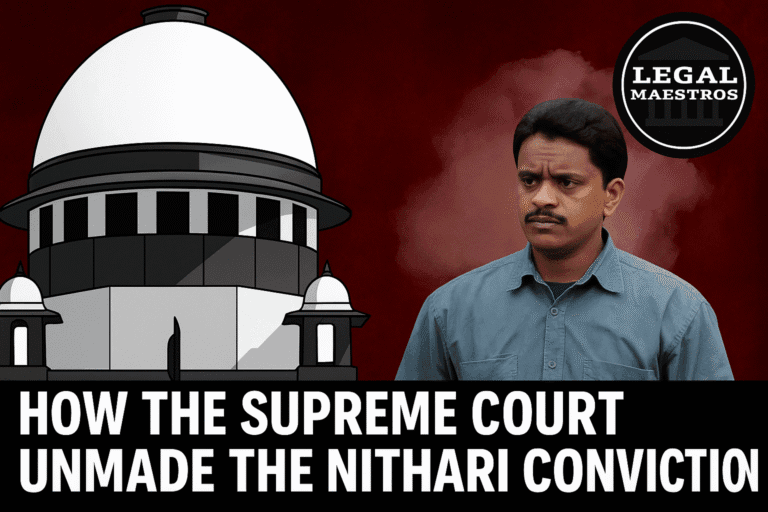
Section 64 of the Bharatiya Nyaya Sanhita, 2023: Punishment for Rape
Introduction
In India, the Indian Penal Code (IPC) of 1860 has been replaced with the Bharatiya Nyaya Sanhita (BNS), which is a substantial legislative reform that will take effect next year. The punishment for the crime of rape is expressly addressed in Section 64 of the BNS, which outlines the punishments for regular cases as well as those that involve aggravating circumstances.
“General Punishment for the Crime of Rape”
In accordance with the provisions of Section 64(1) of the BNS, any person who commits the crime of rape is liable to rigorous imprisonment for a term of not less than 10 years, which may extend to life imprisonment. The exceptions to this rule are the situations that are explained in subsection (2). The perpetrator is also responsible for paying a fee for their actions.
The situation is made worse by the circumstances.
According to subsection (2) of section 64, there are certain circumstances in which the crime of rape is regarded as more terrible than it would otherwise be because of the victim’s fragility or the offender’s position of authority. In situations like these, the punishment is more severe, consisting of a fine in addition to a sentence of rigorous imprisonment for a time that is not less than ten years, which may extend to life imprisonment for the balance of the offender’s natural life.
For any queries or to publish an article or post or advertisement on our platform, do call at +91 6377460764 or email us at contact@legalmaestros.com.
For More Updates & Regular Notes Join Our Whats App Group (https://chat.whatsapp.com/DkucckgAEJbCtXwXr2yIt0) and Telegram Group ( https://t.me/legalmaestroeducators )
Among the aggravating factors are the following:
The perpetrator is a law enforcement officer who has committed a rape within the confines of their police station, on the premises of any station home, or on a woman who is either in their custody or in the custody of a subordinate law enforcement officer.
The perpetrator is a public official who has committed rape on a woman who is either in their custody or in the custody of a public servant who is subordinate to them by title.
For any queries or to publish an article or post or advertisement on our platform, do call at +91 6377460764 or email us at contact@legalmaestros.com.
The perpetrator is a member of the armed forces who is stationed in a region by either the Central or State Government and commits rape in that region.
The perpetrator is a member of the administration or staff of a correctional facility, remand home, or other place of confinement established by law, or of a facility that serves women or children, and they commit rape on an inmate from within the facility.
The perpetrator is a member of the administration or staff of a hospital, and they commit rape against a female patient who is under their care.
For any queries or to publish an article or post or advertisement on our platform, do call at +91 6377460764 or email us at contact@legalmaestros.com.
A relative, guardian, teacher, or other person who is in a position of trust or authority over the lady commits rape on her. * The offender is found to be the perpetrator of the crime.
- The act of rape takes place at times of communal or sectarian strife.
- The perpetrator sexually assaults the victim while being aware that she is pregnant ([ipclaws.in][3])
- It is impossible for the victim to provide their permission.
- The perpetrator is in a position of authority or influence over the victim, also known as the woman.
- The victim is afflicted with a mental or physical physical handicap.
- The perpetrator of the rape causes the victim to suffer severe bodily harm, maims, disfigures, or puts her life in jeopardy while they are conducting the crime.
- The perpetrator commits multiple acts of rape against the same victim female.
Illustration: [Title] In accordance with Section 64(2)(f), an aggravated circumstance is created when a teacher uses their position of responsibility to rape a student. This indicates that the instructor should be subject to a more severe punishment.
The following are clarifications and definitions:
There are three branches of the armed forces: the navy, the army, and the air force. Additionally, any member of the armed forces that is established under any law that is now in effect is included in this category. This includes paramilitary and auxiliary forces that are under the supervision of either the central or state government.
For any queries or to publish an article or post or advertisement on our platform, do call at +91 6377460764 or email us at contact@legalmaestros.com.
The term “Hospital” refers to the areas of the hospital as well as any other institution that facilitates the reception and treatment of individuals who are undergoing convalescence or who require medical attention or rehabilitation.
Police Officer: According to the definition provided by the Police Act of 1861.
An institution that serves either women or children: This term refers to establishments that are formed and maintained for the purpose of receiving and caring for women or children. Some examples of such establishments include orphanages, homes for neglected women or children, and widows’ homes.
For any queries or to publish an article or post or advertisement on our platform, do call at +91 6377460764 or email us at contact@legalmaestros.com.





![Research Assistantship @ Sahibnoor Singh Sindhu, [Remote; Stipend of Rs. 7.5k; Dec 2025 & Jan 2026]: Apply by Nov 14, 2025!](https://legalmaestros.com/wp-content/uploads/2025/11/Gemini_Generated_Image_s0k4u6s0k4u6s0k4-768x707.png)
![Karanjawala & Co Hiring Freshers for Legal Counsel [Immediate Joining; Full Time Position in Delhi]: Apply Now!](https://legalmaestros.com/wp-content/uploads/2025/11/Gemini_Generated_Image_52f8mg52f8mg52f8-768x711.png)